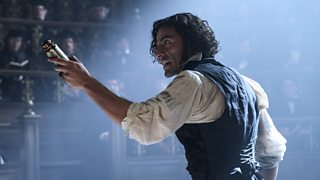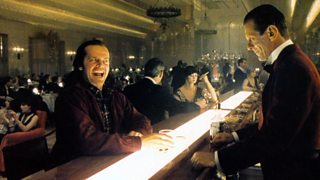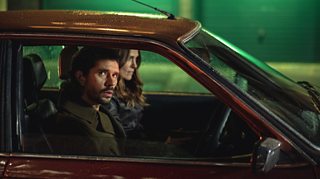Nine of the best versions of Frankenstein on screen
Frankenstein – or rather his monster – has been a cinematic staple for more than a century. The story gets its latest big-screen retelling in 2025 with Guillermo Del Toro's lush Netflix-produced epic.
Written by Mary Shelley in 1818, Frankenstein, the story of a man creating new life from dead bodies, has fascinated filmmakers because it can be interpreted in so many ways. It can be horror. It can be twisted romance. It can be meditation on grief or loneliness. It can be… romcom?
In this episode of ÃÛÑ¿´«Ã½ Radio 4's Screenshot, Mark Kermode and Ellen E Jones speak to Del Toro and a range of movie experts to figure out why people keep resurrecting this idea. These are some of the most memorable takes on the gothic classic.

Frankenstein (1931)
James Whale’s 1931 Frankenstein is the film that brought the monster to the public imagination and established lots of tropes ‘borrowed’ by later adaptations.

“James Whales makes a huge number out of a laboratory with crackling things and lightning [which was not in the book],” says horror expert Anne Bilson. This film also invented the look of the creature, with “bolts through the neck, the flat-topped head, the horrible fringe and lurching walk. It’s a marvellous performance by Boris Karloff [as the creature].”
The Bride of Frankenstein
The 1935 sequel to Whale’s film has the creature in want of a companion, here played by Elsa Lanchester. “It’s probably even better than Frankenstein,” says Anne Bilson. The bride is created at the end of the movie, so only appears briefly, but her dramatic image made her an immediate horror icon. “Wouldn’t it have been great to see her in a series of films?” says Bilson. “It’s such a great character. Such wonderful make-up and hair design.”
The Curse of Frankenstein
Anyone watching this 1957 adaptation, by Hammer Studios, may wonder why the creature (Christopher Lee) just looks like your common zombie. That’s because the flat-top look is Universal’s intellectual property. “They couldn’t use the copyrighted Universal make-up, so they had to start from scratch,” says Anne Bilson. “But the most radical thing Hammer did was to shift focus from the creature, who had stolen the [Universal] film… to the baron himself. Peter Cushing’s baron is a marvellous creation… Deliciously evil.” Hammer would make six sequels, all with different creatures.
Young Frankenstein
Horror and drama became broad comedy in Mel Brooks’ 1974 spoof. In this, the creature is given the wrong brain. “They put a criminal brain in this creature’s head by mistake,” says Anne Bilson. “So when the creature turns violent, it’s not entirely his fault.” It’s the only Frankenstein movie to feature the creature doing a song and dance number. “Absolutely wonderful,” says Bilson.
Edward Scissorhands
As Anne Bilson says, director Tim Burton “[has always been] obsessed with the Frankenstein story and made his own… version twice: Frankenweenie, about a kid who brings his dog back to life.” He made Frankenweenie first as a live-action short, then later a stop-motion animation.
He also a made a looser version: 1990's Edward Scissorhands. It concerns a young man (Johnny Depp) created by a scientist (Vincent Price). When the scientist dies before completing Edward, he leaves him with blades for hands. Edward, like the creature in Frankenstein, finds himself rejected by society. “He can’t embrace the girl he loves because he might cut her,” says Bilson. “It’s a wonderful fairytale. Very beautifully done.”
Mary Shelley's Frankenstein
Frankenstein’s monster had been dormant a while when Kenneth Branagh revived him in 1994. As well as directing, Branagh played Frankenstein, with Robert De Niro as his creature. It had a script by Frank Darabont (The Shawshank Redemption), which was, according to Darabont’s friend Guillermo Del Toro, “a very faithful adaptation of the book.” However, Darabont said the final film is nothing like the one he intended, with Branagh more focused on action than the book’s emotion. The movie has its fans – including Mark – but Anne Bilson says "it’s an utterly ridiculous film".
Lisa Frankenstein
There have been all sorts of playful spins on Frankenstein over the years. One notable recent one was Zelda Williams’ 2024 film Lisa Frankenstein, which turns Shelley’s classic into a romcom.
Its ‘scientist’ is teenager Lisa (Kathryn Newton). “The school gothic nerd who doesn’t get on well with her classmates accidentally reanimates the corpse of a poet,” says Anne Bilson. “She moulds him into her perfect boyfriend, helping herself to body parts from other [people].” It may not grapple with the book’s deeper ideas, but Bilson calls it “actually kind of fun – a bit too much fun, I think.”
The Angry Black Girl and Her Monster
When director Bomani J Story read Mary Shelley’s novel, he was fascinated by Frankenstein’s motivations for creating new life. “The unspoken thing was, ‘Where is this coming from?’” he says. “At the very beginning of the book, his mother dies. I felt like there was this hole he was trying to fill.”
Story’s ingenious 2023 film takes that idea and reframes it, centring a young Black girl in an environment where violence and death are common. After her brother and mother are killed, she vows to bring them back to life. She reanimates her brother, with terrible consequences. “It’s exploring the fight for Black life,” says Story, “because that’s something that’s always being challenged.”

Frankenstein (2025)
Guillermo Del Toro’s passion project has been percolating for about 30 years. “Many times I said, ‘I’m too afraid, I cannot do it!,” says director Del Toro. “I wanted to make an epic and a chamber piece at the same time.”
His 2025 film aims to “capture the spirit of the book”, telling the story in two parts, first from the point of view of Frankenstein (Oscar Isaac), a man consumed by ego, who sees the creature as just an experiment. Then from the creature (Jacob Elordi), who wants to be a person, not a thing. Del Toro says he was interested in exploring someone “completely driven by certainty…[opening up] to the possibility of listening, forgiving and accepting.”
Hear more from Del Toro and Mark and Ellen's exploration into other cinematic tales of reanimation in the full epsiode on ÃÛÑ¿´«Ã½ Sounds.
More articles from Screenshot
-
![]()
Seven of the most memorable vampires in film and TV
Mark and Ellen's pick of the screen vampires with the most bite.
-
![]()
Seven of the most memorable hotels in film and TV
Ellen and Mark check out cinema and TV's finest - and seediest - hotels.
-
![]()
Seven of the most memorable interlopers in cinema
The unwelcome guests who have inveigled their way onto our screens.
-
![]()
Nine of the most memorable hitmen movies and TV shows
Ellen and Mark explore the shady and morally dubious world of hitmen on screen.





